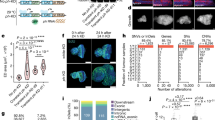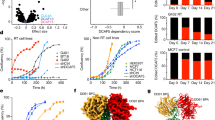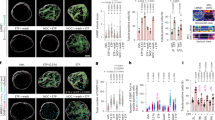Abstract
Cellular senescence is a tumour-suppressor mechanism that is triggered by cancer-initiating or promoting events in mammalian cells. The molecular underpinnings for this stable arrest involve transcriptional repression of proliferation-promoting genes regulated by the retinoblastoma (RB1)/E2F repressor complex. Here, we demonstrate that AGO2, RB1 and microRNAs (miRNAs), as exemplified here by let-7, physically and functionally interact to repress RB1/E2F-target genes in senescence, a process that we call senescence-associated transcriptional gene silencing (SA-TGS). Herein, AGO2 acts as the effector protein for let-7-directed implementation of silent-state chromatin modifications at target promoters, and inhibition of the let-7/AGO2 effector complex perturbs the timely execution of senescence. Thus, we identify cellular senescence as the an endogenous signal of miRNA/AGO2-mediated TGS in human cells. Our results suggest that miRNA/AGO2-mediated SA-TGS may contribute to tumour suppression by stably repressing proliferation-promoting genes in premalignant cancer cells.
This is a preview of subscription content, access via your institution
Access options
Subscribe to this journal
Receive 12 print issues and online access
$209.00 per year
only $17.42 per issue
Buy this article
- Purchase on Springer Link
- Instant access to full article PDF
Prices may be subject to local taxes which are calculated during checkout








Similar content being viewed by others
References
Collado, M. & Serrano, M. Senescence in tumours: evidence from mice and humans. Nat. Rev. Cancer 10, 51–57 (2010).
Narita, M. et al. Rb-mediated heterochromatin formation and silencing of E2F target genes during cellular senescence. Cell 113, 703–716 (2003).
Adams, P. D. Remodeling chromatin for senescence. Aging Cell 6, 425–427 (2007).
Moazed, D. Small RNAs in transcriptional gene silencing and genome defence. Nature 457, 413–420 (2009).
Morris, K. V. RNA-mediated transcriptional gene silencing in human cells. Curr. Top. Microbiol. Immunol. 320, 211–224 (2008).
Janowski, B. A. et al. Involvement of AGO1 and AGO2 in mammalian transcriptional silencing. Nat. Struct. Mol. Biol. 13, 787–792 (2006).
Kim, D. H., Saetrom, P., Snove, O. Jr. & Rossi, J. J. MicroRNA-directed transcriptional gene silencing in mammalian cells. Proc. Natl Acad. Sci. USA 105, 16230–16235 (2008).
Rabinovich, A., Jin, V. X., Rabinovich, R., Xu, X. & Farnham, P. J. E2F in vivo binding specificity: comparison of consensus versus nonconsensus binding sites. Genome Res. 18, 1763–1777 (2008).
Xu, X. et al. A comprehensive ChIP–chip analysis of E2F1, E2F4, and E2F6 in normal and tumor cells reveals interchangeable roles of E2F family members. Genome Res. 17, 1550–1561 (2007).
Ross, J. F., Naar, A., Cam, H., Gregory, R. & Dynlacht, B. D. Active repression and E2F inhibition by pRB are biochemically distinguishable. Genes Dev. 15, 392–397 (2001).
Bieda, M., Xu, X., Singer, M. A., Green, R. & Farnham, P. J. Unbiased location analysis of E2F1-binding sites suggests a widespread role for E2F1 in the human genome. Genome Res. 16, 595–605 (2006).
Rudel, S., Flatley, A., Weinmann, L., Kremmer, E. & Meister, G. A multifunctional human Argonaute2-specific monoclonal antibody. RNA 14, 1244–1253 (2008).
Zhou, Y. et al. High-risk myeloma is associated with global elevation of miRNAs and overexpression of EIF2C2/AGO2. Proc. Natl Acad. Sci. USA 107, 7904–7909 (2010).
Kim, M. S. et al. Somatic mutations and losses of expression of microRNA regulation-related genes AGO2 and TNRC6A in gastric and colorectal cancers. J. Pathol. 221, 139–146 (2010).
Li, L., Yu, C., Gao, H. & Li, Y. Argonaute proteins: potential biomarkers for human colon cancer. BMC Cancer 10, 38 (2010).
Michaloglou, C. et al. BRAFE600-associated senescence-like cell cycle arrest of human naevi. Nature 436, 720–724 (2005).
Dhomen, N. et al. Oncogenic Braf induces melanocyte senescence and melanoma in mice. Cancer Cell 15, 294–303 (2009).
Gray-Schopfer, V. C. et al. Cellular senescence in naevi and immortalisation in melanoma: a role for p16? Br. J. Cancer 95, 496–505 (2006).
Sporn, J. C. et al. Histone macroH2A isoforms predict the risk of lung cancer recurrence. Oncogene 28, 3423–3428 (2009).
Zhang, R. et al. Formation of MacroH2A-containing senescence-associated heterochromatin foci and senescence driven by ASF1a and HIRA. Dev. Cell 8, 19–30 (2005).
Ricke, R. M. & Bielinsky, A. K. Easy detection of chromatin binding proteins by the Histone Association Assay. Biol. Proced Online 7, 60–69 (2005).
Nielsen, S. J. et al. Rb targets histone H3 methylation and HP1 to promoters. Nature 412, 561–565 (2001).
Luo, R. X., Postigo, A. A. & Dean, D. C. Rb interacts with histone deacetylase to repress transcription. Cell 92, 463–473 (1998).
Brehm, A. et al. Retinoblastoma protein recruits histone deacetylase to repress transcription. Nature 391, 597–601 (1998).
Magnaghi-Jaulin, L. et al. Retinoblastoma protein represses transcription by recruiting a histone deacetylase. Nature 391, 601–605 (1998).
Ohtani, K., DeGregori, J. & Nevins, J. R. Regulation of the cyclin E gene by transcription factor E2F1. Proc. Natl Acad. Sci. USA 92, 12146–12150 (1995).
Ro, S. et al. Cloning and expression profiling of testis-expressed piRNA-like RNAs. RNA 13, 1693–1702 (2007).
Krueger, J. & Rehmsmeier, M. RNAhybrid: microRNA target prediction easy, fast and flexible. Nucleic Acid Res. 34, W451–W454 (2006).
Dalton, S. Cell cycle regulation of the human cdc2 gene. EMBO J. 11, 1797–1804 (1992).
Han, J., Kim, D. & Morris, K. V. Promoter-associated RNA is required for RNA-directed transcriptional gene silencing in human cells. Proc. Natl Acad. Sci. USA 104, 12422–12427 (2007).
Bischof, O. et al. The E3 SUMO ligase PIASy is a regulator of cellular senescence and apoptosis. Mol. Cell 22, 783–794 (2006).
Ji, P. et al. An Rb-Skp2-p27 pathway mediates acute cell cycle inhibition by Rb and is retained in a partial-penetrance Rb mutant. Mol. Cell 16, 47–58 (2004).
Chang, B. D. et al. A senescence-like phenotype distinguishes tumor cells that undergo terminal proliferation arrest after exposure to anticancer agents. Cancer Res. 59, 3761–3767 (1999).
Bischof, O, Nacerddine, K. & Dejean, A. Human papillomavirus oncoprotein E7 targets the promyelocytic leukemia protein and circumvents cellular senescence via the Rb and p53 tumor suppressor pathways. Mol. Cell Biol. 25, 1013–1024 (2005).
Kumar, P. P. et al. Functional interaction between PML and SATB1 regulates chromatin-loop architecture and transcription of the MHC class I locus. Nat. Cell Biol. 9, 45–56 (2007).
Frank, S. R., Schroeder, M., Fernandez, P., Taubert, S. & Amati, B. Binding of c-Myc to chromatin mediates mitogen-induced acetylation of histone H4 and gene activation. Genes Dev. 15, 2069–2082 (2001).
Meng, L., Bregitzer, P., Zhang, S. & Lemaux, P. G. Methylation of the exon/intron region in the Ubi1 promoter complex correlates with transgene silencing in barley. Plant Mol. Biol. 53, 327–340 (2003).
Huang, D. W., Sherman, B. T. & Lempicki, R. A. Systematic and integrative analysis of large gene lists using DAVID bioinformatics resources. Nat. Protocols 4, 44–57 (2008).
Liu, C. G., Spizzo, R., Calin, G. A. & Croce, C. M. Expression profiling of microRNA using oligo DNA arrays. Methods 44, 22–30 (2008).
Acknowledgements
We would like to thank A. Verdel and M. Yaniv for discussions and critical reading of the manuscript. We are grateful to P. Adams for providing the anti-macroH2A antibody to U.H. and N. Mirani for technical help with histopathology as well as S. Volinia and C. Croce for miRNA profiling and J. Doudement (GenomeQuest, France) for bioinformatics analysis. This work was supported by grants from Ligue Nationale Contre le Cancer (Equipe labellisée), Association for International Cancer Research, Agence Nationale de la Recherche, Association pour la Recherche sur le Cancer (ARC), OdysseyRe and the New Jersey Commission on Cancer Research 09-1124-CCR-EO to U.H. O.B. is a CNRS (Centre National de la Recherche Scientifique) fellow, A.D. Institut National de la Santé et de la Recherche Médicale (INSERM)/Institut Pasteur and M.B. was supported by ARC.
Author information
Authors and Affiliations
Contributions
O.B. and M.B. conceived the project. M.B. carried out experiments. O.B., M.B. and A.D. analysed the data. U.H. carried out immunohistochemical staining on nevi and melanomas. T.Y. carried out bioinformatic analysis. O.B. and A.D. wrote the manuscript.
Corresponding authors
Ethics declarations
Competing interests
The authors declare no competing financial interests.
Supplementary information
Supplementary Information
Supplementary Information (PDF 1256 kb)
Supplementary Table 1
Supplementary Information (XLS 285 kb)
Supplementary Table 2
Supplementary Information (XLS 10 kb)
Supplementary Table 3
Supplementary Information (XLS 29 kb)
Supplementary Table 4
Supplementary Information (XLS 296 kb)
Supplementary Table 5
Supplementary Information (XLS 29 kb)
Supplementary Table 6
Supplementary Information (XLS 33 kb)
Rights and permissions
About this article
Cite this article
Benhamed, M., Herbig, U., Ye, T. et al. Senescence is an endogenous trigger for microRNA-directed transcriptional gene silencing in human cells. Nat Cell Biol 14, 266–275 (2012). https://doi.org/10.1038/ncb2443
Received:
Accepted:
Published:
Issue Date:
DOI: https://doi.org/10.1038/ncb2443
This article is cited by
-
Molecular mechanisms of transgenerational epigenetic inheritance
Nature Reviews Genetics (2022)
-
A non-coding RNA balancing act: miR-346-induced DNA damage is limited by the long non-coding RNA NORAD in prostate cancer
Molecular Cancer (2022)
-
Early onset senescence and cognitive impairment in a murine model of repeated mTBI
Acta Neuropathologica Communications (2021)
-
The double face of miR-320: cardiomyocytes-derived miR-320 deteriorated while fibroblasts-derived miR-320 protected against heart failure induced by transverse aortic constriction
Signal Transduction and Targeted Therapy (2021)
-
AP-1 imprints a reversible transcriptional programme of senescent cells
Nature Cell Biology (2020)



